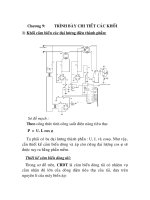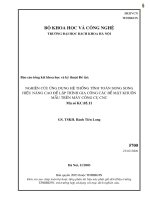3G Workshop May 2005 - Richard Edge.ppt
Bạn đang xem bản rút gọn của tài liệu. Xem và tải ngay bản đầy đủ của tài liệu tại đây (1.93 MB, 26 trang )
New Concepts for Optimization
Enhanced Approaches Using Measured Data
presenter Richard Edge
Contents
Developing a new concept - Veritune
Validating the Veritune concept
Developing a practical solution
Conclusions
Developing a
new concept
- Veritune
Is this really the best way of
doing things?
(Picture – Testing Golf Clubs by Heath-Robinson)
The importance of antenna optimization in
UMTS
If a cell causes too much
interference in a UMTS /
WCDMA network…
… frequency planning is no
longer an option…
…the only options are
power and antenna
optimisation.
Downtilt, azimuth and power
changes control are used to
control radio propagation
Antenna optimisation in
UMTS is both more frequent
and important than in GSM
networks.
A typical antenna optimization process
Changes identified by:
Predicted data
‘Ranging’ spreadsheets
Experience…
Antenna
changes
in field
KPI analysis
cost
Uncertain results
Time-consuming
Field
drive drive 03
Optimized!
Validation
02
01
Identify changes to
antenna coverage
time
How do we speed up the process?
Reducing the loops is key
to reducing time to revenue:
Get an acceptable solution
as early as possible.
How do we improve the
certainty that our changes
will work?
Field
drive
Validation
Drive
Test drive 02
01
Time consuming
Antenna
changes
in field
KPI analysis
Relatively quick
Identify changes to
antenna coverage
Some principles for a new concept in
optimisation to reduce the number of loops
Improve prediction accuracy by simplifying
the problem (rather than increasing the
complexity of the model)
Wherever possible use real data (rather
than predicting measurable information)
Guide the user towards the solution (rather
than prescribing a solution automatically)
Present results in the same format as
measured data (rather than presenting a grid
of data)
(Picture – NASA Space Pen)
Review – how a planning tool predicts network
performance
Antenna Masking
Required inputs: Map database, antenna
performance and configuration
Interfering
Cells
Modified
Cell
Link Budget
Required inputs:
Equipment
performance &
configuration.
Path Loss
Required inputs: Map
database, model
diffraction/penetration/
reflection assumptions.
Interference Generation
Required inputs: Map database, model
diffraction/penetration/ reflection assumptions, antenna
performance and configuration, traffic geographical
distribution, building penetration, interferer link budget, traffic
modelling, power control, RRM modelling, mobile location in
buildings.
The planning tool prediction process
Traffic
Model
Map Data
Pathloss
Prediction
Propagation
Model
Antenna Masking
Model
Pilot EcNo
Site
Configuration
Channel Model
Traffic Map
Pilot
RSCP
RSSI
Service
EbNo
Served
Users
Applying the principles - Veritune
Antenna Masking
Required Inputs: Map database, antenna
performance and configuration
Interfering
Cells
Modified
Cell
Link Budget
Not Required.
Path Loss
Measure Signal Strength.
Interference Generation
Required Inputs: Map database, antenna performance and
configuration of changed interfering cells.
The Veritune prediction process
Measured
Pilot EcNo
Measured
Pilot RSCP
Antenna Masking
Model
Map Data
Site
Configuration
Pilot RSCP
Pilot EcNo
An improved antenna optimisation process
with Veritune
Optimized!
Field
Validation
drive drive 02
01
Optimisation loops are
taken out of the field onto
the desktop
cost
Antenna
changes
in field
KPI analysis
Less cycles
saves time,
reduces cost
time
Traditional process
With Actix Veritune
Actix Veritune
on desktop
Validating the Veritune concept
Validation approach
Actix Veritune
Before
Drive
Configuration
Changes
Traditiona
l Tuning
Synthetic
Drive
Comparison
After
Drive
• Validation was carried out using historically collected data.
• Synthetic drives calculated off ‘before’ measured drives
were compared to ‘after’ measured drives, and the error at
each data bin calculated.
Input measurements
Trials of 4 clusters (33 sector changes, 20 control sectors)
have been carried out across a variety of rural, suburban
and urban environments, in flat and hilly terrain.
A total of 8545 data bins were considered, approximately
427km driving.
No data filtering was carried out:
Sector heights ranged between 12m and 48m
Measurements both within and beyond the main lobe by
bearing were considered
All ranges were considered up to 14km (including less than
500m)
The validation results
Standard deviations significantly improve upon typical
propagation model accuracies (benchmark 8dB – top of the below
graph).
The mean error was within 1dB of the control set for all clusters.
8
Standard Deviation (dB)
7
6
5
Control
4
Veritune
3
2
1
0
Rural/Suburban A
Rural/Suburban B
Urban
Hilly dense urban
4.8dB
without 2
outlying
sectors
How consistent are the results?
A majority of sectors exhibited consistent performance:
20
Number of Sectors
18
16
standard deviation
14
mean
12
10
8
6
4
2
0
0 to 1
1 to 2
2 to 3
3 to 4
4 to 5
5 to 6
6 to 7
7 to 8
8 to 9
9 to 10
Range (dB)
Outlying
sectors
Distribution of error with distance
Error Plot with Distance
30.00
20.00
Error (dB)
10.00
0.00
Rural
-10.00
-20.00
-30.00
0
2000
4000
6000
8000
Distance (m)
10000
12000
14000
Developing a practical solution
Implementing the principles in practice
1
2
3
Enabling 3 easy steps to fast, in-office optimization:
Step 1. Identify poorly performing areas
Step 2. Review guidance towards possible solution
Step 3. Simulate the effect of antenna changes









